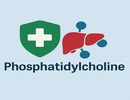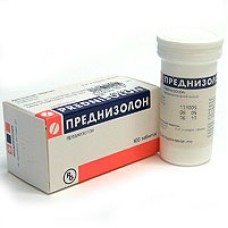Prednisolon (Methylprednisolone) 4mg #30
Description for Prednisolon (Methylprednisolone) 4mg #30
International name:
Methylprednisolone (Methylprednisolone)
Group Affiliation:
Glucocorticosteroid
Description of the active substance (INN):
Methylprednisolone
Dosage form:
lyophilized for solution for intravenous and intramuscular injection, a suspension for intramuscular injection, suspension for injection
Pharmacological Effects:
GCS, inhibits the release of interleykina1, interleykina2, interferon gamma from lymphocytes and macrophages. Has anti-inflammatory, antiallergic, desensitizing, antishock, anti-toxic and immunosuppressive effects. Inhibits the release of pituitary ACTH and beta-lipotropina, but does not reduce the concentration of circulating beta-endorphin. Inhibits the secretion of TSH and FSH. Increases the excitability of the CNS, reduces the number of lymphocytes and eosinophils, increases - erythrocytes (stimulates the production of erythropoietin). Interacts with specific cytoplasmic receptors and forms a complex that penetrates the cell nucleus, and stimulates the synthesis of mRNA, the latter induces the formation of proteins, including lipokortina mediating cellular effects. Lipokortin inhibits phospholipase A2, inhibits the release of arachidonic acid and inhibits the synthesis of endoperekisey, Pg, leukotrienes, contribute to the process of inflammation, allergies and other protein metabolism: it reduces the amount of protein in the plasma (due to globulin) with an increase in the coefficient of albumin / globulin, albumin synthesis increases in liver and kidneys, strengthen protein catabolism in muscle tissue. Lipid metabolism: it increases the synthesis of higher fatty acids and triglycerides, redistributes fat (fat accumulation predominantly in the shoulder girdle, face, abdomen), leads to the development of hypercholesterolemia. Carbohydrate metabolism: increases the absorption of carbohydrates from the digestive tract, increases the activity of glucose-6-phosphatase, which leads to an increase of glucose from the liver into the blood, increases the activity and synthesis фосфоэнолпируваткарбоксилазы aminotransferases, resulting in the activation of gluconeogenesis. Water and electrolyte metabolism: Na + and delayed water in the body, stimulates the excretion of K + (ISS activity), reduces the absorption of Ca2 + from the digestive tract, "washes" Ca2 + from bone, increases excretion of Ca2 + by the kidneys. Anti-inflammatory effect associated with inhibition of inflammatory mediators released by eosinophils, inducing formation lipokortina and reduce the number of mast cells that produce hyaluronic acid, a decrease in the permeability of capillaries, stabilizing cell membranes and membrane organelles (especially the lysosomal). Antiallergic effect develops as a result of the suppression of synthesis and secretion of mediators of allergy, inhibition release from sensitized mast cells and basophils of histamine and other biologically active substances that reduce the number of circulating basophils, suppressing the development of lymphoid and connective tissue, reducing the number of T-and B-lymphocytes, mast cells, reducing the sensitivity of effector cells to the mediators of allergy, inhibition of antibody production, changes in immune response. Antishock and anti-toxic effect associated with increased blood pressure (by increasing the concentration of circulating catecholamines and recovery of sensitivity to his blockers, and vasoconstriction), decrease the permeability of the vascular wall, the properties of membrane, activation of liver enzymes involved in the metabolism of endo-and xenobiotics. Immunosuppressive effect is inhibition of the release of cytokines (interleykina1, interleykina2, interferon gamma) from lymphocytes and macrophages. Inhibits the synthesis and secretion of ACTH and second - the synthesis of endogenous corticosteroids. Inhibits connective tissue reaction in the inflammatory process and reduces scarring. COPD is mainly based on inhibition of inflammatory processes, inhibition of the development or prevention of swelling of mucous membranes, inhibition of eosinophilic infiltration of the submucosal layer of the bronchial epithelium, deposition in the bronchial mucosa of circulating immune complexes and inhibition erozirovaniya and desquamation of the mucosa. Increases the sensitivity of beta-adrenergic bronchial small-and medium-sized to endogenous catecholamines and exogenous sympathomimetics, reduces the viscosity of mucus due to oppression or reduce its production. At 5 times more active than hydrocortisone for anti-inflammatory effects. After i / m injection of 80 mg of the drug its effect lasts for 12 hours, and suppressive effect on plasma cortisol levels is observed for 17 days.
Indications:
Shock (burns, traumatic, operations, toxic, cardiogenic) after failure of other therapies. Allergic reactions (acute, severe), transfusion shock, anaphylactic shock, anaphylactoid reaction. Cerebral edema (including the background of a brain tumor or associated with surgery, radiotherapy, or head trauma). Asthma (severe), asthmatic status. Systemic connective tissue diseases (SLE, rheumatoid arthritis). Acute adrenal insufficiency. Thyrotoxic crisis. Acute hepatitis, hepatic coma. Poisoning with cauterizing liquids (decrease inflammation and prevent scarring of the restrictions).
Contraindications:
For short-term use of "life" readings only contraindication is hypersensitivity. For intra-articular injection: previous arthroplasty, abnormal bleeding (endogenous or caused by the use of anticoagulants), intra-articular fracture, infection (sepsis) inflammation in the joints and periarticular infections (including history), as well as general infectious disease marked periarthric osteoporosis, lack of signs of inflammation in the joints (so-called "dry" joint, such as osteoarthritis without synovitis), marked bone destruction and deformity of the joint (a sharp narrowing of joint space, ankylosis), the instability of the joint as a result of arthritis, aseptic necrosis of the epiphyses of bones forming the joint. C care. Parasitic and infectious diseases of viral, fungal or bacterial origin (currently or recently transferred, including the recent contact with a patient) - herpes simplex, herpes zoster (viraemic phase), chicken pox, measles, amoebiasis, strongyloidiasis (or suspected); system mycosis, active and latent tuberculosis. Application of serious infectious diseases is admissible only against the background of specific therapy. Post-vaccination period (the period of duration of 8 weeks before and 2 weeks after vaccination), lymphadenitis after BCG vaccination. Immunodeficiency (including AIDS or HIV infection). Diseases of the digestive tract - stomach ulcer and 12 duodenal ulcer, esophagitis, gastritis, acute or latent peptic ulcer, recently created by anastomosis of the intestine, ulcerative colitis with the threat of perforation or abstsedirovaniya, diverticulitis. Diseases of the cardiovascular system, including recent myocardial infarction (in patients with acute and subacute myocardial necrosis may spread, slowing the formation of scar tissue and because of that - break the heart muscle), decompensated heart failure, hypertension, hyperlipidemia). Endocrine diseases - diabetes (including breach of tolerance to carbohydrates), hyperthyroidism, hypothyroidism, pituitary basophilia. Severe chronic renal and / or liver failure, nefrourolitiaz. Hypoalbuminemia and conditions predisposing to its occurrence. Systemic osteoporosis, myasthenia gravis, acute psychosis, obesity (III-IV cent.), Polio (with the exception of the bulbar form of encephalitis), an open-and angle-closure glaucoma, pregnancy and lactation. For intra-articular injection: general grave condition of the patient, the ineffectiveness (or brevity) of the 2 previous injections (with regard to individual properties apply GCS).
Side effects:
The frequency and severity of side effects depend on the duration of application, the values used by the dose and adhering to the circadian rhythm of destination. From the endocrine system: impaired glucose tolerance, "steroid" diabetes, or a manifestation of latent diabetes mellitus, adrenal suppression, Cushing's syndrome Itsenko-(moon face, obesity, pituitary type, hirsutism, increased blood pressure, dysmenorrhea, amenorrhea, myasthenia gravis, Austria) , delayed sexual development in children. From the digestive system: nausea, vomiting, pancreatitis, "steroid" stomach ulcers and 12 duodenal ulcers, erosive esophagitis, bleeding and perforation of the gastrointestinal tract, increased or decreased appetite, flatulence, hiccups. In rare cases - increased activity of liver transaminases and alkaline phosphatase. From the CAS: arrhythmia, bradycardia (down to heart failure), development (in predisposed patients) or increased severity of heart failure, ECG changes characteristic of hypokalemia, increased blood pressure, hypercoagulability, thrombosis. In patients with acute and subacute myocardial infarction - the spread of necrosis, slowing the formation of scar tissue that can lead to rupture of the heart muscle. The nervous system: delirium, disorientation, euphoria, hallucinations, manic-depressive psychosis, depression, paranoia, increased intracranial pressure, nervousness or anxiety, insomnia, dizziness, vertigo, pseudotumor cerebellum, headache, convulsions. From the sensory organs: a sudden loss of vision (for parenteral administration in the head, neck, nasal cavities, the scalp may deposit crystals of the drug in the vessels of the eye), posterior subcapsular cataracts, increased intraocular pressure with possible damage to the optic nerve, the propensity to develop secondary bacterial , fungal or viral infections of the eye, trophic changes of the cornea, exophthalmos. From a metabolism: increased excretion of Ca2 +, hypocalcemia, weight gain, negative nitrogen balance (increased protein breakdown), increased sweating. Caused by the ISS-activity - fluid retention and Na + (peripheral edema), hypernatremia, gipokaliemichesky syndrome (hypokalemia, arrhythmia, myalgia or muscle spasm, unusual weakness and fatigue). From the musculoskeletal system: slowing growth and ossification processes in children (premature closure of epiphyseal growth zones) and osteoporosis (very rare - pathological fractures, aseptic necrosis of the humeral head and femur), rupture of tendons of muscles, "steroid" myopathy, reduced
Prednisolon (Methylprednisolone) 4mg #30
- Product Code: 85
- Availability: In Stock
-
$22.00
- Ex Tax: $22.00

